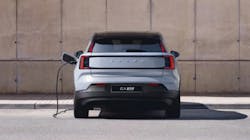Volvo latest to connect Tesla Supercharger partnership in North America
Volvo Cars is joining the parade in an ever growing line of automakers marching to the tune of Tesla’s Supercharger melody in North America.
The Swedish firm became the first European car marker to sign a deal with Tesla giving current and future Volvo electric car drivers access to the charging infrastructure that is fast becoming a de facto standard for the e-mobility industry. Volvo’s move follows GM, Ford and Rivian in seeking Supercharger accommodation.
Beginning in 2025, Volvo battery electrics will be equipped with the North American Charging Standard ports. This will give electric Volvos access to 12,000 new fast-charge points across the U.S., Canada and Mexico.
“As part of our journey to becoming fully electric by 2030, we want to make life with an electric car as easy as possible,” Jim Rowan, CEO at Volvo Cars, said in a statement. “One major inhibitor to more people making the shift to electric driving – a key step in making transportation more sustainable – is access to easy and convenient charging infrastructure. Today, with this agreement, we’re taking a major step to remove this threshold for Volvo drivers in the United States, Canada and Mexico.”
Grid integration and EV Charging: A Utility Challenge in focus at T&D World Live
Sessions on EV-Grid Challenges featuring Amazon, North American Council on Fleet Efficiency and PG&E
Register now/Discounts for Utility Groups
Those Volvo drivers already had access to tens of thousands of other charging points. Drivers who buy future Volvo electrics which have the NACS charge port can still utilize the current Combined Charging System (CCS) technology with an adapter provided by the carmaker, Volvo reported.
Volvo recently announced two new EV models, EX30 and EX90, to join a line of offerings that include the XC40 and C40 Recharge. The company also is pouring more than $1 billion into upgrading its Torslanda manufacturing plant in Sweden, as well as $118 million in its South Carolina facility, to ramp up EV production.
Earlier this month, GM announced it was converting its charging standard to the Tesla and NACS ports beginning in 2025. Current GM EV drivers can utilize those Supercharger stations with a special adapter starting 2024.
The GM announcement came only two weeks after Ford said it also was partnering with Tesla on a similar timetable. Smaller EV maker Rivian followed GM’s decision with a Supercharger partnership of its own.
Tesla launched its charging standard in 2012 with the market entry of the Model S sedan. NACS Superchargers outnumber other charging models and are considered to be faster than rivals.
In 2022, solar EV maker Aptera Motors got in front of the market desire for Supercharger standards and petitioned Congress to make NACS the go-to for EV charging. Company co-founders Chris Anthony and Steve Fambo even wrote a statement posted on change.org calling for the adoption of the Tesla charging technology in the U.S.
“If our country began to support Tesla’s charging standards now, we could begin expanding our infrastructure at a much reduced cost, saving $4 billion on projected charging infrastructure spending through 2027,” Anthony and Fambo wrote on the website. “Image what other EV programs we could support that $4 billion in savings.”
Ford’s EV division alone has vowed to commit at least $50 billion to EV production through 2026. Two years ago, GM reported plans to allocate $35 billion toward vehicle electrification through 2025.
About the Author
Rod Walton, EnergyTech Managing Editor
Managing Editor
For EnergyTech editorial inquiries, please contact Managing Editor Rod Walton at [email protected].
Rod Walton has spent 17 years covering the energy industry as a newspaper and trade journalist. He formerly was energy writer and business editor at the Tulsa World. Later, he spent six years covering the electricity power sector for Pennwell and Clarion Events. He joined Endeavor and EnergyTech in November 2021.
Walton earned his Bachelors degree in journalism from the University of Oklahoma. His career stops include the Moore American, Bartlesville Examiner-Enterprise, Wagoner Tribune and Tulsa World.
EnergyTech is focused on the mission critical and large-scale energy users and their sustainability and resiliency goals. These include the commercial and industrial sectors, as well as the military, universities, data centers and microgrids. The C&I sectors together account for close to 30 percent of greenhouse gas emissions in the U.S.
He was named Managing Editor for Microgrid Knowledge and EnergyTech starting July 1, 2023
Many large-scale energy users such as Fortune 500 companies, and mission-critical users such as military bases, universities, healthcare facilities, public safety and data centers, shifting their energy priorities to reach net-zero carbon goals within the coming decades. These include plans for renewable energy power purchase agreements, but also on-site resiliency projects such as microgrids, combined heat and power, rooftop solar, energy storage, digitalization and building efficiency upgrades.

